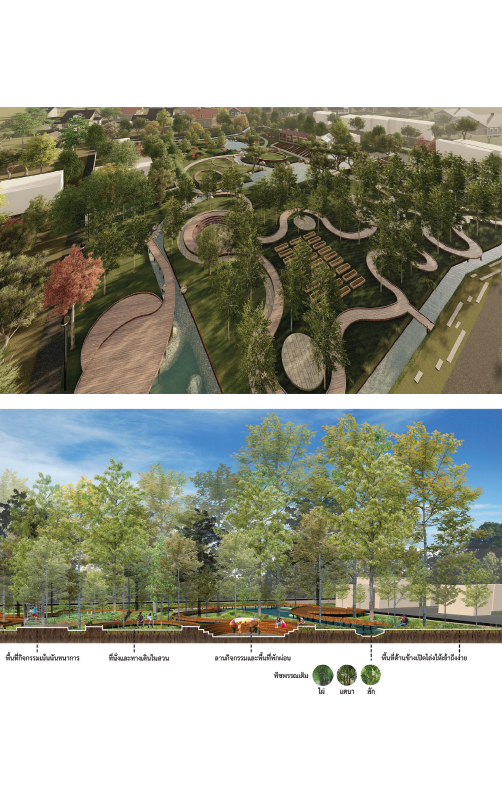Urban green space development from public land certificate: case study of Wiang Yong subdistrict municipality, Lamphun province
Keywords:
development of green space, public benefits, community plan, public land certificateAbstract
This research paper is part of a community planning project on the preservation of urban green spaces to serve as a tool for the cities’ sustainable management of green and open spaces. Development of urban green space with the participation of the community and concerned agencies for the public benefit of Wiang Yong sub-district municipality, Lamphun province, employs the workflow that brings the community plan maintain green areas. These are cities that have the potential to develop and focus on green space design that drive quality green spaces in creating sustainable urban green spaces. Research findings showed the following: (1) community participation is still significant for development of area or spaces, proving that communities have demands for green spaces that do not respond to recreation, but green spaces that provide both economic and environmental benefits; (2) green areas from public land certificate are a collection of many public green spaces for development as well as conservation that are useful for the community, and (3) the concept of green space development in the target cities leading to goals of “Green area + water + people”, result to a community plan for conserving green areas in the city with potential for development and providing municipalities with public green spaces to push quantitative and qualitative goals. It consists of a green area in the public land certificate that has the potential of 15 community public space in community with the design guidelines for consisting of 4 areas is proposed. The community see the image. Moreover, there is provides the municipality for developing green areas that connect to the urban green area network and also improves public green areas based on the concept of sustainable green space design that can serve benefits to the urban population. Quality green areas support a variety of uses or functions both of recreation and learning for creating or generating jobs or community income as well.
References
Industrial Estate Authority of Thailand. (2019). Khumue karn truat pramoen phuea haikarnraprong karn pen mueang utsahakam choeng niwet radap eco champion. (In Thai) [Smart eco industrial town]. Bangkok: Author.
Jino,T., et al. (2021). karn phatthana phuen thi satharana phuea soemsang chumchon khemkhaeng: koranee sueksa thetsaban tambon San Pa Pao changwat Chiang Mai. (In Thai) [Public space development for community empowerment : a case study of San Pa Pao, Chiang Mai]. Journal of Environmental Design, 8 (1), 61-77.
Kerdkankaew, S. (2013). Rangwan Asian dan singwaetlom mueang thi yangyuen. (In Thai) [Asean environmentally sustainable cities award]. Bangkok: Office of Natural Resources and Environmental Policy and Planning.
Miller, R. W. (2007). Urban forestry: planning and managing urban greenspaces. Illinois:Waveland Press.
Office of Natural Resources and Environmental Policy and Planning. (2019). Mattrathan attrasuan phuenthi siKhiao thi mosom samrap chumchon mueang nai prathet Thai. (In Thai). [Guidelines for green area management and green area ratio standards for urban communities in Thailand]. Retrieved January 15, 2021, from http://www.onep.go.th/ebook/eurban/eurban-publication-01.pdf.
Office of Natural Resources and Environmental Policy and Planning and Mae Jo University.(2021). Khumue karn prayot chai thankhomun sarasonthet phumisart. (In Thai) [Quantum geographic information system]. Bangkok: Author.
Petri, A., et al. (2016). How green are trees? - using life cycle assessment methods to assess net environmental benefit. Journal of Environmental Horticulture, 34(4), 101–110.
Suteethorn, K. (2022). Khokhit chak karn prachum pa nai mueang : wangphaen pa nai mueang lae saphawa lok ron 2022 kap karn prayuk chai nai khrongkarn pluk tonmai lan ton khong Krungthepmahanakhon. (In Thai) [Key takeaways from urban forests: forest urbanism & global warming conference 2022 and the application to Bangkok’s one million trees project]. Landscape Architecture Journal, 4 (1), 162-177.
Taksayos, N. (2022). Karn phatthana thidin brao fin nai prathet Thai. (In Thai) [Brownfield redevelopment in Thailand]. Landscape Architecture Journal, 4 (1), 26-42.
Uthaisa, V. & Dankittikul, C. (2022). Phuen thi long wang nai khet mueang kao Nakhon Ratchasima lae phuenthi tonueang. (In Thai) [Open space in old town of Nakhon Ratchasima and its adjacent areas]. Landscape Architecture Journal, 4 (1), 43-61

Downloads
Published
Issue
Section
License
Copyright (c) 2023 Faculty of Architecture, Chiang Mai University

This work is licensed under a Creative Commons Attribution-NonCommercial-NoDerivatives 4.0 International License.


